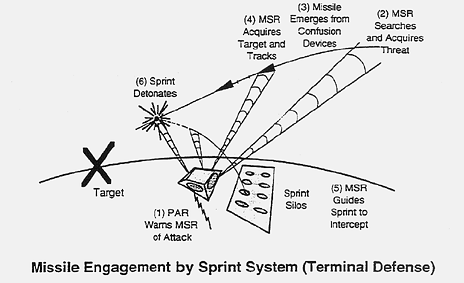By operating within the atmosphere, terminal defense using the Sprint was able to target only true threats, since other spurious targets such as ICBM booster fragments, decoys, and chaff would have been destroyed by atmospheric friction during re-entry. The trade off for this advantage was the extremely limited amount of time available for Sprint to do its job.
Its need for ultra fast acceleration made Sprint a remarkable missile. It was launched from its climate controlled silo by being tossed into the air by a gas discharge mechanism at the bottom of the silo after the silo cover had been blown off by an explosive charge. The first stage ignited as it cleared the silo, propelling the missile to hypersonic speed in seconds. Internal components were designed to withstand accelerations of 100g (100 times gravity). The second stage reached velocities that caused atmospheric friction to heat the skin of the missile to the point that it glowed incandescantly; a flame from an acetylene torch would have cooled it.
Terminal defense using the Sprint required "close in" interception. In an attempt to minimize the time between launch and interception, Sprint launchers were dispersed over a wide geographical area. Sprint missile fields were located at the MSR complex as well as at four geographically dispersed remote Sprint launch sites (RSL's) that were arrayed around the MSR complex at 10 to 20 mile distances.
Launch, guidance, and warhead detonation were all controlled by the MSR; its high power beam was capable of penetrating the plasma sheath that surrounded the missile after it reached full velocity. Targets were destroyed by detonation of Sprint's neutron warhead which was specifically designed to minimize collateral damage from its "close in" detonation.
-
Specifications:
-
Official spec sheet:
(494 x 295 = 37k)
(894 x 534 = 91k) 003808
-
Launchers: 70 total, 16 at the MSR site and 54 dispersed among the four RSL's (1 (12), 2 (12), 3 (16), 4 (14)). (With the 30 Spartans, there was a total of 100 launchers as specified by the SALT I treaty.)
-
Length: 27 feet
-
Diameter: 4 feet 6 inches (at base)
-
Weight: 7,500 pounds
-
Fuel: Solid propellant
-
Stages: 2
-
Maximum engagement altitude: 24 miles
-
Range: Approximately 25 miles
-
Guidance: Ground-based radio directed
-
Warhead: Nuclear, low-kiloton range yield
-
Primary Contractor: Martin Marietta
-
Additional Information:
-
Sprint description from the Historical American Engineering Record (HAER) document about the SRMSC.
-
ABM R & D at Bell Laboratories: Project History, Part II, Chapter 9 (PDF).
-
astronautix.com: Sprint ABM (New window) <$
